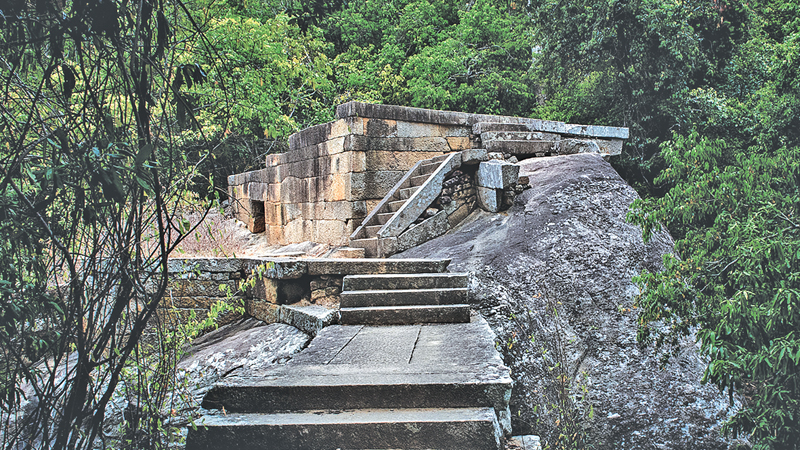 Sri Lanka is blessed with many varied sites of historical and cultural importance that visitors are spoilt for choice. While the expensive ruins of the ancient cities of Anuradhapura and Polonnaruwa have a grandeur that is hard to surpass, there are lesser-known sites with an ambience all their own. This frequently stems from the fact that they lie off the beaten track, are on a smaller scale and are encircled and even encroached by jungle.
Sri Lanka is blessed with many varied sites of historical and cultural importance that visitors are spoilt for choice. While the expensive ruins of the ancient cities of Anuradhapura and Polonnaruwa have a grandeur that is hard to surpass, there are lesser-known sites with an ambience all their own. This frequently stems from the fact that they lie off the beaten track, are on a smaller scale and are encircled and even encroached by jungle.
One such site is the monastic complex on the lower slopes of the rocky mountain of Ritigala kanda, 30 kilometres north of Habarana in the North Central Province. The steep jungle-clad mountain, rising imposingly to a height of 2,514 ft (765m) above the surrounding plain was easy enough to spot as we travelled the Anuradhapura to Habarana main road. From this point, Ritigala gives the illusion of being extremely close.
Meditation platforms
These ruins are some of the most distinctive the island has to offer. The Ritigala hermitage largely consists of meditation platforms and walkways that are in perfect harmony with the huge boulders, trees and streams of the sylvan environment.
These inspiring ruins are situated in Ritigala, a mountain steeped in legend and mystery. I made my first visit to Ritigala nearly 20 years ago, when just getting there was an adventure in itself. However, I had an opportunity to visit this amazing archaeological site again on my way to Anuradhapura recently. The 2nd Century rocky mountain site is now home to ruins of a forest hermitage complex of an austere sect of forest-dwelling bhikkhus who occupied the hermitage in the northern slope of the mountain.
Archaeologists discovered east-west aligned double platforms and stone pavements, both of which are thought to have been used for meditation, features unique to the forest hermitages. The main stone pathway weaves through overgrown foliage, gradually ascending into a clearing with rock caves and paths leading further into the jungle. Discovered only 120 years ago by British Surveyor James Martell, the exact etymology of the name is still unclear, but the most commonly-espoused theory is ‘safety rock’ – ‘gala’ is Sinhala for rock, while ‘riti’ is thought to come from the Pali ‘arittha’ (safety). The mountain is referred to repeatedly in the Mahavamsa as a refuge for a long list of royal fugitives.
It is also mentioned as the ancient mountain of Aristha in the Ramayana text, from where the warrior monkey-God Hanuman leapt to India to pass on the news to Lord Rama that his wife Sita had been captured by Ravan, the Lankan demon king.
Legend tells of Hanuman returning to the mountain to deliver herbs to save the life of Rama’s brother who was wounded in battle, which is supposed to account for the unique plant species found on its plateau.
Pansukulika bhikkhus
From the 3rd Century until it was abandoned 700 years later after the overthrow of Anuradhapura, Ritigala was home to a long line of hermetic dwellers. The most famous residents were the deeply ascetic Pansukulika bhikkhus – who took a vow to wear only robes made from the cloth in which corpses were wrapped. It is believed the hard-liner group revolted against the comfortable life of their brethren in Anuradhapura to revive the austere life led by the Buddha. Their dedication was greatly admired and it was King Sena I who commissioned the building of the hermitage of which the remains can be seen today.
Like Arankele in Kurunegala, Ritigala is littered with straight stone pavements and double platforms; the latter believed to be a primitive form of air-conditioning for congregational meditation practice. After passing the ruins of a small hospital with stone beds and oil baths, you reach an intricately carved urinal stone, displaying the only example of iconographic imagery in the whole of Ritigala.
Three-hour trek
In addition to the ruins, there is a three-hour trek up to the summit of the mysterious, mist-clad mountain rising from the surrounding plain, the highest single peak in the country.
Much can change in 20 years, even an archaeological site but thankfully Ritigala remains largely the same. The Ritigala Mountain, including the monastic complex has been declared a sanctuary and protected area to preserve its pristine environment.
The Archaeological Department has sensitively restored many of the ruins as part of UNESCO’s Cultural Triangle Project, giving visitors today a clearer impression of their splendour.








